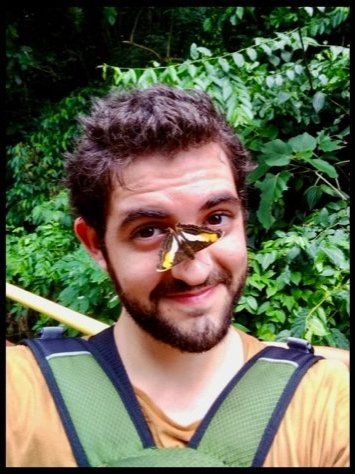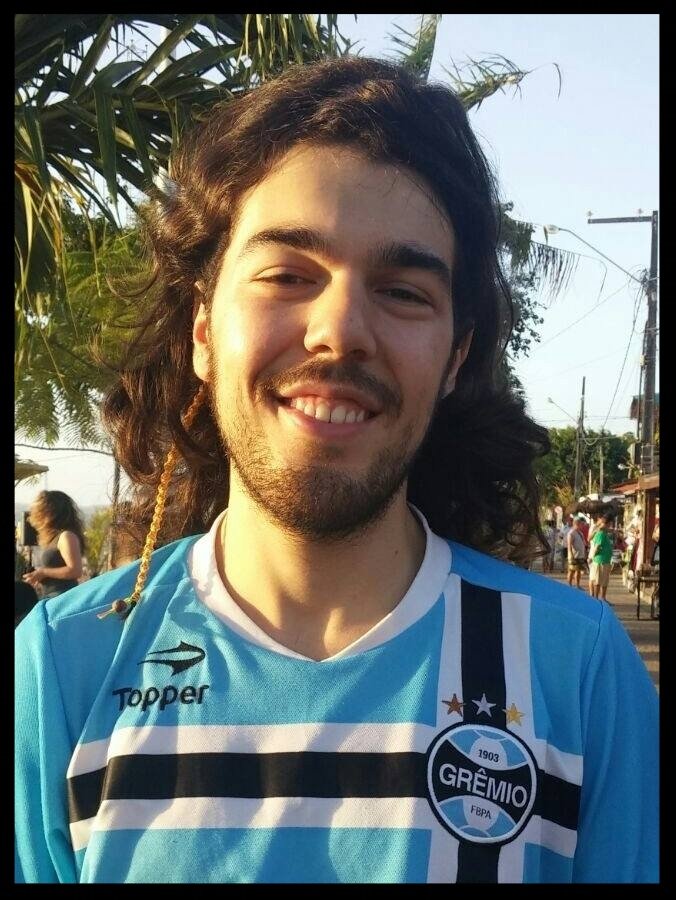lab head
Gonçalo Ferraz (PhD Columbia University 2004)
Gonçalo got his undergraduate degree from the University of Lisbon and PhD in Ecology & Evolutionary Biology from Columbia University. A biologist by training, he was initially motivated by an interest in birds and natural history, which gradually developed into a fascination for counting living organisms in every possible way. Gonçalo's current work is centered on demography of non-human populations, with an emphasis on studying animal population responses to landscape change. He heads the Ferraz's Population Biology Laboratory since 2004, first, as a CNPq and STRI post-doc, based at INPA and Fiocruz, and now as Associate Professor at UFRGS, where he was hired in 2013. Gonçalo’s CV & Email.
students
Diego Zavala (BA UNSA-Arequipa 2018)
Diego got his undergraduate degree in biology from the Universidad Nacional de San Agustín de Arequipa, in Peru. He has a special interest in hole-dwelling animals, starting with bats, but now including also cavity-nesting birds. The MSc project that Diego is developing in our lab builds multi-state occupancy models to understand the dynamics of cavity use in two neotropical forest sites with different assortments of cavity users. The project is a collaboration with Alexander Gonzales, in Costa Rica, and with Kristina Cockle, in Argentina, who were extremely kind to share their data with us.
Ricardo Rohweder (BA UNINTER 2019)
Ricardo has an undergraduate degree in Philosophy and is currently pursuing a MSc in Genetics and Molecular Biology at UFRGS. He joined the lab as a teaching assistant in 2017, supervising a citizen-science mosquito monitoring initiative. This led to an interest in mosquito population biology, which turned into a Master’s project. Due to the Covid-19 pandemic, however, Ricardo could not carry out his field work and reoriented his plans towards the study of SARS-Cov-2 transmission in Rio Grande do Sul. Ricardo’s work examines the relationship between non-pharmaceutical measures adopted by the health authorities and estimates of Rt for different regions of the state throughout 2020.
Fábio Wood (LD UFRGS 2022)
A licensed lawyer, Fábio passed the Brazilian equivalent of the Bar exam in early 2022, but he is pursuing an undergraduate degree in Biology since March 2020. Fábio joined the lab as an intern right at the end of his first Biology semester. He learned programming, sat on the graduate hierarchical modeling class, and now works as a Research Assistant developing multi-species dynamic site-occupancy models of Amazon forest birds. Fábio is working with output of Ulisses Camargo’s automated identification of bird sound recordings to understand secondary forest colonization by old growth understory forest birds in the Amazon.
some collaborators
Viviane Zulian (MSc UFRGS 2017, PhD UFRGS 2021)
As a Biology undergraduate at the Universidade Comunitária da Região de Chapecó, Viviane developed an interest in the Vinaceous Parrot (Amazona vinacea), a threatened species with a wine-collored breast, a fondness for Araucaria seeds, and odd, regional migratory movements. In her MSc and PhD at the Lab Viviane combined her past experience of counting parrots with a range of recently developed statistical methods for estimating the global abundance and for redrawing the geographic range of the species. Viviane is currently a Postdoctoral Researcher at the Department of Applied Ecology at the North Carolina State University, where she is developing models to estimate the abundance of Red Snappers (Lutjanus campechanus) in the Atlantic Ocean, along the East coast of the United States . Viviane's CV & Email.
Letícia Soares (MSc INPA 2010, PhD UMSL 2016)
Letícia is an evolutionary biologist with interests in ornithology, parasitology, biogeography and molecular biology. Her research centers on host-parasite evolution and interactions, with a focus on host-parasite systems, such as malaria and Chagas disease, where a group of phylogenetically related pathogens can infect both human and animal hosts in the wild. Letícia completed her MSc. in Ecology at INPA in 2010, advised by Drs. Ferraz and Fernando Abad-Franc (FIOCRUZ-AM). Her master's thesis investigated sex-biased incidence of cutaneous leishmaniasis in human populations. She is now a 6th-year PhD candidate in the Ricklefs lab, at the University of Missouri Saint Louis. Letícia co-manages a science outreach blog, The Naked Darwin.
Ulisses Camargo (MSc INPA 2011, PhD University of Helsinki 2018)
Ulisses' interests center on population modeling and numerical ecology; he is currently a PhD candidate at the University of Helsinki, working at the Metapopulation Research Centre. His doctoral work combines autonomous recording of bird vocalizations, automated identification of the recorded signals, and hierarchical Bayesian methods for analyzing the identification results. By integrating these resources, Ulisses is developing a novel, multidisciplinary approach to study the dynamics of tropical bird communities. Ulisses is a Biologist trained at the University of São Paulo in Ribeirão Preto and joined the lab as an MSc. student at INPA, in 2009. He headed the lab's autonomous recording crew for five consecutive years. Ulisses’ CV & Email
Aída Rodrigues (MSc INPA 2010)
A biologist trained at Universidade Federal do Amazonas, Aída is interested in natural history, evolution of visual signals, and the influence of behavior on population dynamics. She joined the lab as a INPA MSc student in 2010, where she found that army ant-following birds have equally high site-fidelity in secondary and old-growth forests, even though these birds rely on a resource that appears to be less predictable in secondary forests. Aída is currently a PhD student at Endler’s Lab (Deakin University, Australia) where she studies acoustic and visual signals in courtship displays of the Great Bowerbird. Her current obsessions include bowerwatching, stone collecting (too much hanging out with bowerbirds!), and swing dancing with her mates. Aída's CV & Email
Murilo Guimarães (PhD UNICAMP 2013)
Murilo has a B.A. in biology from Universidade Católica de Santos and a Master’s in Animal Biology from Universidade Estadual Paulista. During his PhD at the Ecology Department of UNICAMP, he used mark-recapture models to estimate amphibian and reptile population parameters. He is currently a Postdoctoral fellow at INPA under the supervision of Drs. Jansen Zuanon and Gonçalo Ferraz. Murilo’s current work is divided between modeling survival and movement of stream fish in experimental field settings, and mapping spatial distribution of nocturnal birds. His main interests are quantitative population ecology, field sampling techniques, and swimming. Murilo’s CV & Email
gone but not forgotten
Guilherme Morés (MSc UFRGS 2019)
Guilherme (aka Morés) joined the lab as an undergraduate student in 2016 and stayed on to develop an MSc project starting in February 2017. Guilherme is collaborating with the Porto Alegre city council to study temporal dynamics of Aedes aegypti mosquito infestation in the city. His employs site-occupancy models to analyze mosquito detection data from several hundred sample sites spread throughout the city. Morés’ scientific interests center on mathematical modelling of population dynamics in ecology. His project aims to apply modeling skills to the effectively tackle a public health problem with relevant implications for society.
Bruna Rodrigues do Amaral (BA UFRGS 2019)
Bruna is pursuing her undergraduate degree in Biological Sciences at Universidade Federal do Rio Grande do Sul. She applied for an undergraduate research assistantship at the lab, motivated by her interest in population dynamics and quantitative ecology. Bruna's work at the lab centers on improving a digital tool for assisting researchers in learning and memorizing bird vocalizations from the Biological Dynamics of Forest Fragments Project area. She is also helping to process digital vocalization recordings and to manage the our recording database. Bruna started working at the lab in March 2015. Bruna's CV & E-mail.
Bento Collares Gonçalves (BA UFRGS 2014)
Bento is a UFRGS-trained biologist who joined the lab as an undergraduate in 2013. His work was an attempt to gauge the extent of false positive errors on bioacoustic sampling of Central Amazon birds. To do this, Bento used an online quiz supplied with bird vocalization recordings. For simplicity, his study was taxonomically restricted to antbirds and woodcreepers – including some of the most common and well known birds in the study area. Not surprisingly, Bento's results showed that false positive errors are pervasive in our study setting; he even drew a dendrogram of his study group, based solely on identification errors. Bento is now a PhD student in the Department of Ecology and Evolution at Stony Brook University, New York. Bento's CV and Email.
Thiago B. D'Araújo Couto (MSc INPA 2013)
Thiago got his undergraduate training in Biology at the Universidade de Brasília and joined the lab in 2011 as an INPA Ecology MSc. student co-advised by Gonçalo and Jansen Zuanon. Thiago is currently a PhD student advised by Dr. Julian Olden at the University of Washington, Seattle. Thiago's research interests center on aquatic ecology, and the effects of landscape disturbance on the spatial distribution and natural history of stream fishes. Thiago's MSc project employed a multi-species occupancy model to examine whether some stream fish are restricted to the most temporary of the upstream environments .Thiago's website & Email.
Marconi Campos Cerqueira, Jr. (MSc INPA 2009)
Best bird ear in the lab for a long time, Marconi got his undergraduate Biology degree at the Universidade Federal de Ouro Preto in the state of Minas Gerais. His MSc project about rarity of primary forest birds pioneered the use of a spaced-repetition learning software to help observers memorize bird sounds. He found that most expert predictions about who is rare and who is common were qualitatively right and produced estimates of site occupancy that provide a solid basis for assessing rarity. Marconi is now a PhD candidate at the University of Puerto Rico – Rio Piedras, supervised by Dr. Mitchell Aide . Marconi's CV & Email
Alejandra Pizarro (BA Universidad de Antioquia 2009)
Biologist trained in Medellín, Colombia, Alejandra became interested in birds as an undergraduate and since then worked in ornithology from a variety of perspectives, including education, bird-banding, and environmental consulting*. She returned to academia in 2014 driven by a desire to learn statistics and theoretical ecology, with an eye to better interpret her field observations. Alejandra's MSc project at the lab aims to estimate the effect of age on survival of Amazon forest understory birds; to do this, she is employing Cormack-Jolly-Seber models of mist net capture-recapture data. Though not a fan of stereotypes, Alejandra does love dancing salsa. Alejandra's CV and Email. *Small green creature in the photo is not a bird.
Giuliano Müller Brusco (BA UFRGS 2011)
A biologist trained at Universidade Federal do Rio Grande do Sul, Giuliano has a strong background in field Ornithology. He graduate in 2011 and, after a stint as environmental consultant, returned to academia motivated by an urge to get the numbers right. Giuliano joined the lab as a UFRGS Ecology MSc. student in March 2015. His project is aimed at measuring intra-specific, age-dependent variation in home range size among birds of the Biological Dynamics of Forest Fragments Project area. This variation, if it is measurable, should contribute towards a better understanding on inter-specific variation in bird-population density. Giuliano loves ringing birds with his lab mates. Common name: Ceará. Giuliano's CV & Email.
Camila Leão da Silveira (BA UFRGS 2013)
Camila obtained a B.A. degree in Biology in 2013, from the Universidade Federal do Rio Grande do Sul (UFRGS). Currently, she is pursuing an MSc. degree, also at UFRGS, with a project that studies relationships between physical condition and survival probability among Amazon old growth and secondary forest understory birds. Camila has broad professional interests spanning population biology, scientific communication, and scientific education. In 2015, she broke the world record for 100-m dash tapir escape. Camila is an MSs. student at the lab since March, 2015. Camila's CV & E-mail
Page in construction. Several people missing...















![IMG_0305 [Resolucion de Escritorio].jpg](https://images.squarespace-cdn.com/content/v1/55a307f8e4b0b796f2028213/1446082466202-X4VMMF5FTK5YKLSW6DR0/IMG_0305+%5BResolucion+de+Escritorio%5D.jpg)

